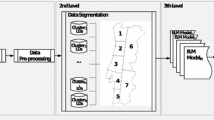Abstract
This paper presents a comparison of the impact of various unsupervised ensemble learning methods on electricity load forecasting. The electricity load from consumers is simply aggregated or optimally clustered to more predictable groups by cluster analysis. The clustering approach consists of efficient preprocessing of data gained from smart meters by a model-based representation and the K-means method. We have implemented two types of ensemble learning methods to investigate the performance of forecasting on clustered or simply aggregated load: bootstrap aggregating based and the newly proposed clustering based. Two new bootstrap aggregating methods for time series analysis methods were newly proposed in order to handle the noisy behaviour of time series. The smart meter datasets used in our experiments come from Ireland and Slovakia, where data from more than 3600 consumers were available in both cases. The achieved results suggest that for extremely fluctuate and noisy time series unsupervised ensemble learning is not useful. We have proved that in most of the cases when the time series are regular, unsupervised ensemble learning for forecasting aggregated and clustered electricity load significantly improves accuracy.
Access this chapter
Tax calculation will be finalised at checkout
Purchases are for personal use only
Similar content being viewed by others
References
Laurinec, P., Lucká, M.: Comparison of representations of time series for clustering smart meter data. In: Proceedings of WCECS, pp. 458–463 (2016)
Laurinec, P., Lóderer, M., Vrablecová, P., Lucká, M., Rozinajová, V., Ezzeddine, A.B.: Adaptive time series forecasting of energy consumption using optimized cluster analysis. In: Proceedings of IEEE ICDMW, pp. 398–405 (2016)
Adhikari, R., Verma, G., Khandelwal, I.: A model ranking based selective ensemble approach for time series forecasting. Procedia Comput. Sci. 48, 14–21 (2015)
Shen, W., Babushkin, V., Aung, Z., Woon, W.L.: An ensemble model for day-ahead electricity demand time series forecasting. In: e-Energy 2013, pp. 51–62. ACM (2013)
Grmanová, G., Laurinec, P., Rozinajová, V., Ezzedine, A.B., Lucká, M., Lacko, P., Vrablecová, P., Návrat, P.: Incremental ensemble learning for electricity load forecasting. Acta Polytech. Hung. 13(2), 97–117 (2016)
Shahzadeh, A., Khosravi, A., Nahavandi, S.: Improving load forecast accuracy by clustering consumers using smart meter data. In: Proceedings of IJCNN (2015)
Wijaya, T.K., Vasirani, M., Humeau, S., Aberer, K.: Cluster-based aggregate forecasting for residential electricity demand using smart meter data. In: Proceedings of IEEE International Conference on Big Data, pp. 879–887 (2015)
Arthur, D., Vassilvitskii, S.: K-means++: the advantages of careful seeding. In: SODA 2007, pp. 1027–1035 (2007)
Davies, D.L., Bouldin, D.W.: A cluster separation measure. IEEE Trans. Pattern Anal. Mach. Intell. 2, 224–227 (1979)
Cleveland, R.B., et al.: Seasonal-trend decomposition procedure based on LOESS. J. Off. Stat. 6, 3–73 (1990)
Box, G.E.P., Jenkins, G.M.: Time Series Analysis: Forecasting and Control. Holden-Day, San Francisco (1970)
Holt, C.C.: Forecasting seasonals and trends by exponentially weighted moving averages, vol. 52. ONR Research Memorandum, Carnegie Inst. of Tech. (1957)
Hyndman, R.J., Koehler, A.B., Snyder, R.D., Grose, S.: A state space framework for automatic forecasting using exponential smoothing methods. Int. J. Forecast. 18(3), 439–454 (2002)
Breiman, L., Friedman, J.H., Olshen, R.A., Stone, C.J.: Classification and Regression Trees. Chapman and Hall/CRC, Wadsworth (1984)
Hyndman, R.J., Khandakar, Y.: Automatic time series forecasting: the forecast package for R. J. Stat. Softw. 27(3), 1–22 (2008)
Strasser, H., Weber, C.: On the asymptotic theory of permutation statistics. Math. Methods Stat. 8, 220–250 (1999)
Breiman, L.: Bagging predictors. Mach. Learn. 24(2), 123–140 (1996)
Bergmeir, C., Hyndman, R.J., Benítez, J.M.: Bagging exponential smoothing methods using STL decomposition and Box-Cox transformation. Int. J. Forecast. 32(2), 303–312 (2016)
Ester, M., Kriegel, H.P., Sander, J., Xu, X.: A density-based algorithm for discovering clusters in large spatial databases with noise. In: Proceedings of the KDD, pp. 226–231 (1996)
Ankerst, M., Breunig, M.M., Kriegel, H.P., Sander, J.: OPTICS: ordering points to identify the clustering structure. In: Proceedings of ACM SIGMOD, pp. 49–60 (1999)
Acknowledgments
This work was partially supported by the Scientific Grant Agency of The Slovak Republic, Grant No. VG 1/0752/14 and STU Grant scheme for Support of Young Researchers.
Author information
Authors and Affiliations
Corresponding author
Editor information
Editors and Affiliations
Rights and permissions
Copyright information
© 2018 Springer International Publishing AG, part of Springer Nature
About this paper
Cite this paper
Laurinec, P., Lucká, M. (2018). Usefulness of Unsupervised Ensemble Learning Methods for Time Series Forecasting of Aggregated or Clustered Load. In: Appice, A., Loglisci, C., Manco, G., Masciari, E., Ras, Z. (eds) New Frontiers in Mining Complex Patterns. NFMCP 2017. Lecture Notes in Computer Science(), vol 10785. Springer, Cham. https://doi.org/10.1007/978-3-319-78680-3_9
Download citation
DOI: https://doi.org/10.1007/978-3-319-78680-3_9
Published:
Publisher Name: Springer, Cham
Print ISBN: 978-3-319-78679-7
Online ISBN: 978-3-319-78680-3
eBook Packages: Computer ScienceComputer Science (R0)




